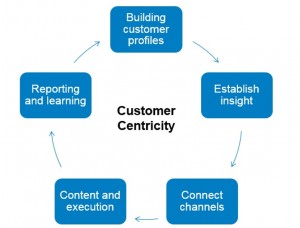One of the central marketing concepts for most companies across industries in recent time is omni-channel marketing. The main idea is to ensure a consistent and comprehensive customer experience across all points of interactions, regardless of time, place and context. Appealing as the thought might be, most companies struggle with the actual execution. Experience shows that omni-channel engagement across digital and analogue touchpoints where interactions are based on historic and immediate data captured and utilized in real-time requires radical changes in both organizational mind-set and technological infrastructure.
“Digital is transforming our job as an insurer and we are convinced that this is a tremendous opportunity to do our job better: protecting people, their goods and their projects on the long term.
It is the customer who will decide the speed of adoption. The important thing is to be ready.”
Véronique Weill, Chief Operating Officer of the AXA Group.
As one of our customers states in this quote, the continuous focus on aligning omni-channel strategy and execution is a necessity to meet the demands of customers, hand-in-hand with our overall objectives as an organization.
In my daily work and in my teaching at Copenhagen Business School, I have been researching, sparring and implementing this type of logic in leading national and international companies for years. I have not seen any company undertaking these changes overnight – albeit identified a somewhat comparable methodology. A process typically has an end; however, in this case I actually consider this a continuous exercise – including new people, processes and technologies as they appear.
Figure 1: The figure shows the identified standard process when executing an omni-channel strategy and is based on best practice and experience.
As shown in the figure, the main elements of the process for executing an omni-channel strategy are:
- Building customer profiles: As a basis for working omni-channel, a company needs to identify and gather all data elements related to prospects and customers to form unified “master customer profiles“. Data resides in a wide range of systems across the organizations such as sales and call center systems, e-mail marketing engines, web and e-commerce sites as well as on various social platforms. Data is automatically merged and managed on a real-time basis.
- Establish insight: Once data has been gathered on individual customers, it is possible to establish insights to support customer interactions. These insights can be based on both business logic and analytics. Business logic is a series of hypothesis based on experience from historic performance and knowledge of employees, which can be structured against a general contact policy – and gradually adjusted as insights are improved with response and behavior from interactions. Analytics is hypothesis based on statistics, which follows the same iterative adjustments as business logic.
- Connect channels: When the foundation is in place, the various channels and platforms currently used for interaction are now integrated, initially selecting the channels with most customer interaction to work seamlessly together – creating a consistent and coherent experience at any time relevant. This includes both below the line media and above the line media. Flexibility is needed as new digital platforms and channels continue to emerge.
- Content and execution: A part of establishing an omni-channel customer engagement is to ensure that there is an overview and availability of all the possible messages to facilitate the interaction. These messages can be service- and sales-related and somewhat different, depending on channels and platforms. The seamless integration ensures that the right message is always chosen at the right time in the right channel.
- Reporting and learning: Working omni-channel requires a new way of working with performance. Real-time omni-channel interactions imply constant monitoring and analyzing performance together with the identification of new and more adequate indicators. With constant interactions, a key performance indicator (KPI) could be “engagement“ hand-in-hand with “profitability“. The dynamics of competitors and customer interests demands a similar approach to reporting where metrics are constantly challenged, changed and replaced to ensure continued learning and proactive engagement.
The methodology is industry agnostic as one needs to specify the individual steps to the company situation. To that, I have developed a white paper that deals with this in relation to the financial industry here (see top to the right: “The Digital Bank 2.0“). For the retail industry, we have developed a visionary video which shows the possibilities with a structured omni-channel process – see the video here (YouTube).
Customer demands are growing in terms of relevance of our interactions – and although most companies still hold on to existing go-to-market models and organizations structures, it will not last long before others will revolutionize these industries as I have commented on before – and completely change the name of the game. It is therefore fundamental that organizations begin their transformation into a more dynamic and proactive character that enables the execution of these necessary and highly valuable omni-channel strategies.

